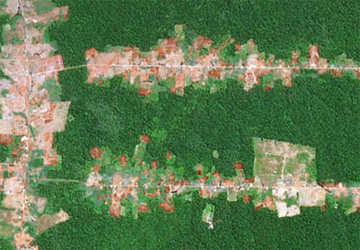Brazilian government is biggest destroyer of the Amazon rainforest
Brazilian government is biggest destroyer of the Amazon rainforest
mongabay.com
September 30, 2008
|
|
A Brazilian government agency changed with land distribution to the poor is the largest driver of deforestation since 2005, according to the country's environmental ministry.
Speaking Monday, Environment Minister Carlos Minc said that the Institute of Colonization and Agrarian Reform (Incra) was responsible for the clearing of 220,000 hectares (550,000 acres) of rainforest on six Amazon properties. The six properties are the largest deforested areas in the entire Brazilian Amazon since 2005.
INCRA, an agency that is supposed to help poor communities find land to settle and develop, has been harshly criticized by scientists and environmentalists in recent years. Last year an eight-month investigation by Greenpeace found that INCRA may be working with logging firms to profit from land reform initiatives.
 Deforestation in the Brazilian Amazon. Image courtesy of Google Earth |
The land reform agency allegedly collaborated with logging companies to identify areas of interest for timber extraction then set up large settlements in these tracts of rainforest instead of placing them in already deforested areas. Timber firms then purchased the land on the cheap for logging. Greenpeace says the scheme gave loggers access to attractive timber, while helping INCRA meet President Luiz Ignácio Lula da Silva's land reform targets just prior to his re-election campaign. Settlers won land and payments for selling holdings to loggers.
In 2006 INCRA created 97 "sustainable development settlements" (PDS) covering 2.2 million hectares near Santarém in Pará, the Amazonian state where American nun Dorothy Stang was gunned down in 2005.
"All these settlements were created in the last three months of last year," an INCRA employee told The Independent last August. "It was the end of Lula's first term so he had to accomplish the targets. It is politicians who will benefit from the PDS system."
In his remarks Monday, Minc also said that deforestation in August 2008 was 760 square kilometers, more than tree times the 230 square kilometers lost in August 2007.
This week Brazil will release a plan to reduce net forest clearing to zero by 2015. The plan is expected to rely heavily on the conversion of natural forest to industrial forest plantations to meet its goal.
Related articles
Brazil plans to cut Amazon deforestation to zero by 2015
(9/26/2008) Brazil aims to cut net deforestation to zero by 2015 according to a plan that will be released by the government next week.
Amazon deforestation jumps 69% in 2008
(8/31/2008) Deforestation in the Brazilian Amazon increased 69 percent in the past 12 months as high commodity prices have driven forest conversion for ranches and cropland, according to preliminary figures released by Brazil's National Institute for Space Research (INPE). The increase comes after three consecutive years of declining deforestation in Brazil.
Future threats to the Amazon rainforest
(7/31/2008) Between June 2000 and June 2008, more than 150,000 square kilometers of rainforest were cleared in the Brazilian Amazon. While deforestation rates have slowed since 2004, forest loss is expected to continue for the foreseeable future. This is a look at past, current and potential future drivers of deforestation in the Brazilian Amazon.
More than 8% of the Brazilian Amazon is illegally owned
(6/14/2008) More 42 than million hectares — eight percent — of the Brazilian Amazon is not legally owned, reports a study released last week by a national environmental NGO.